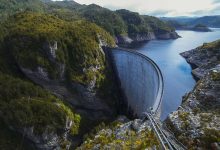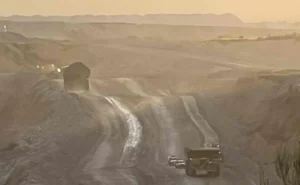Tasmania is a step closer to establishing itself as the ‘battery of the nation’ after the Gutwein state government secured a $95 million agreement with the Morrison federal government to accelerate the creation of new electricity linkages with the Australian mainland, and the development of the state’s first pumped hydro energy storage project.
The deal with Tasmania, one of a series of bilateral deals struck between Canberra and various states over the past year, the federal government will take a majority stake in the investment vehicle supporting the Marinus Link project from Tasmania to the mainland, taking its investment to date to $150 million.
“What we’re achieving in this agreement is we go to the next phase of the Battery of the Nation and the Marinus Link projects,” prime minister Scott Morrison said at the launch of the agreement at the Trevallyn hydroelectric power station in northern Tasmania.
“The commonwealth is increasing our investment of up to $150 million to get us through the design and approval phase. In the agreement today, we establish the special purpose vehicle, which will carry the project forward.”
It is the latest in a series of interventions from the federal government, including money from the Underwriting New Generation Investment scheme that will support the state’s first pumped hydro project, various deals with state governments to support infrastructure projects, Monday’s intervention into the emergency reserve market and, of course, the construction of the massive Snowy 2.0 pumped hydro scheme.
“Of course, there are more hurdles to clear into the future, but as the premier just said, the technical and economic feasibility is very, very sound,” Morrison said.
However, like Snowy 2.0, the “battery of the nation” project has not met with universal approval, with several energy analysts questioning its viability, and whether it would be better to focus on distributed and mostly battery storage in Victoria, and opposition from former Greens leader Bob Brown and Christine Milne.
Under the Tasmanian deal, the federal and state governments will establish a new ‘joint special purpose corporate vehicle’ that will oversee the development of the Marinus Link project, with ownership split between the two governments. The federal government has also agreed to underwrite the ongoing development works for a pumped hydro energy storage project at Lake Cethana.
The Marinus Link project, which is key to a larger plan to establish Tasmania as the ‘battery to the nation’, will significantly expand the amount of electricity that can be shared between Tasmania and mainland Australia and will provide new opportunities with the further development of Tasmania’s wind and pumped hydro energy storage resources.
Tasmania is currently connected to Australia’s main grid through the BassLink undersea cable, that allows up to 500MW of power to be sent to and from Victoria.
Marinus Link could see another two undersea links between Tasmania and the mainland, adding up to 1,500MW in new undersea interconnector capacity, enabling Tasmania to continue to grow its renewable energy supplies and taking the state well beyond 100 per cent renewable electricity.
The project has already benefited from a fast-tracked federal government approval process, prioritised under a ‘jobmaker’ plan to accelerate investment in new major infrastructure projects.
A separate part of the agreement will see the development of new pumped hydro energy storage facilities at Tasmania’s Lake Cethana and is expected to be the first major project that had been shortlisted under the Morrison government’s Underwriting New Generation Investments program to receiving funding support.
An additional investment of $650 million, with the involvement of the state-owned Hydro Tasmania, will also be made in expanding existing generation facilities at the Tarraleah hydroelectric power station, that will ultimately take advantage of the increased ability to export power from Tasmania through the Marinus Link. Works at the Tarraleah expansion are expected to commence next year.
Tasmanian premier Peter Gutwein said that a total of $7 billion in investment could be supported by the project, facilitating further investments in expanding the state’s hydroelectric and pumped hydro energy storage projects, as well as additional wind farms.
“The MOU will help to further unlock Tasmania’s renewable energy potential, with thousands of jobs and over $7 billion in economic activity set to flow as a result,” Gutwein said.
“Having already achieved 100 per cent self-sufficiency in renewables, Tasmania is already punching above its weight in generating low cost, reliable, clean energy for the nation, and this will help us achieve our target to double our renewable generation to 200 per cent of our current needs by 2040.”
The Tasmanian government recently declared that the state had built enough new wind generation capacity, operating alongside the state’s substantial hydroelectricity resources, to meet 100 per cent of the state’s energy needs with renewable energy sources.
The Gutwein Tasmanian government has moved to formally legislate a 200 per cent renewable electricity target, that it wants to achieve by 2040, as part of a strategy to establish the state as a renewable energy exporter.
Tasmanian energy minister Guy Barnett added that Tasmania was well-positioned to supply the rest of Australia with electricity supplies that addressed the energy ‘trilemma’.
“We’re leading the way. Tasmania has the trifecta; affordable, reliable and clean electricity,” Barnett said. “We have what the rest of Australia needs and wants. We have what the rest of the world needs and wants, and Tasmania has natural assets with our world-class water resource, our world-class wind resource, and we’re delivering jobs on the ground here in Tasmania.”









